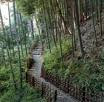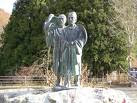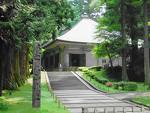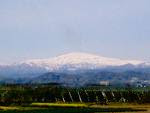:::::::::::::::::::::::::::::::::::::::::::::::::::::::::::::::::::::::::::::::::::::::::::::::::::
BACKUP only
December 2012
Original
. WKD : Oku no Hosomichi 2007 .
The main entry is now HERE
Oku no Hosomichi - 奥の細道 - おくのほそ道
. Matsuo Basho 松尾芭蕉 Archives of the WKD .
:::::::::::::::::::::::::::::::::::::::::::::::::::::::::::::::::::::::::::::::::::::::::::::::::::
walking
a long, long path -
haiku
:::::::::::::::::::::::::::::::::::::::::::::::::::::::::::::::::::::::::::::::::::::::::::::::::::
Oku no Hosomichi 奥の細道 ... 2007

月日は百代の過客にして、行かふ年も又旅人也。
つきひははくたいのかかくにして
つきひはひゃくだいのかきゃくにして
tsukihi wa hakutai no kakaku ni shite
(tsukihi wa hyakudai no kakyaku ni shite)
yukikau toshi mo mata tabibito nari.
Days and months are the travellers of eternity.
The years that pass are also but travellers in time.
松尾芭蕉
Basho was 46 when he started his tour on the 27 of March, 1689. (May 16 in the modern solar calendar.)
His tour took him over 2400 kilometers on foot! It took him five years to complete his report of this walk. It includes 51 hokku and is not a simple diary, but a work of literature, including fiction and philosophy.
He visited many "poetic pillows", uta makura 歌枕, famous places where poets before him had been visiting and writing poetry about.
While he was thus travelling the road of former famous poets like Saigyo, he was also travelling along his own life, even toward the future. He lived in a time when the age of 50 was considered a good time to die!
Jinsei, gojuu nen! 人生五十年!
:::::::::::::::::::::::::::::::::::::::::::::::::::::::::::::::::::::::::::::::::::::::::::::::::::
................................... Some general information
"All Things Must Pass" , nothing is eternal
sarvasamskara anityah in orignal Sanskrit
Shogyoo Mujoo 諸行無常 (しょぎょうむじょう) Mujo
. Barnhill : the concept of MUJŌ .
impermanence
:::::::::::::::::::::::::::::::::::::::::::::::::::::::::::::::::::::::::::::::::::::::::::::::::::
"permanence and change",
synthesis between tradition and innovation
Fueki Ryuukoo 不易流行(ふえきりゅうこう)
QUOTE:
fuga no makoto is a result or product of the dynamism of two colliding forces: fueki ryuko, which is another important teaching of Basho.
Fueki simply means "no change" and refers to values of a permanent and enduring nature.
Ryuko, on the other hand, means "changing fashions of the time" and refers to newness, innovation, originality or unconventional values that would break with old ways in a revolutionary manner.
For instance, Beethoven created new and innovative music, ushering in a new age and setting a new trend. However, he did not do so without first having been steeped in classical music of an old tradition. Thus he had fueki ryuko and left legacy of permanent value.
None of us is Beethoven, but all of us can become a little Beethoven! Fueki ryuko is an abbreviation of senzai-fueki ichiji-ryuko (eternal no-change and temporary fashion).
When fueki and ryuko collide and interact in a dynamic explosion of creative haiku writing, the result could be like a newly born baby taking after both parents but different from both. And there is a single ultimate value that lies beyond fueki ryuko, and that is nothing but fuga no makoto.
Susumu Takiguchi, WHR 2005
..............................................
Basho edited the haiku presented in "Oku no Hosomichi" according to the rules of RENKU, including moon, cherry blossoms and two about love.
© Etsuko Yanagibori
:::::::::::::::::::::::::::::::::::::::::::::::::::::::::::::::::::::::::::::::::::::::::::::::::::
A first ku (hokku) that can stand alone, usually with a mention of a special area, an independent hokku, is called
jihokku 地発句(じほっく)
The last ku of a linked verse is "ageku 挙句", and there is a popular Japanese proverb, ageku no hate 挙句の果て, at the last ku, meaning "at last".
:::::::::::::::::::::::::::::::::::::::::::::::::::::::::::::::::::::::::::::::::::::::::::::::::::
The walk starts in Edo.
行く春や鳥啼き魚の目は泪
yuku haru ya tori naki uo no me wa namida
spring is leaving ..
birds sing and the eyes of fish
are full of tears
Basho at Senju 千住
in 1689, taking final leave from his friends.
. Yuku haru - spring is ending .
:::::::::::::::::::::::::::::::::::::::::::::::::::::::::::::::::::::::::::::::::::::::::::::::::::
江東区芭蕉記念館
KOTO CITY BASHO MUSEUM
Basho-An Homepage
臨川寺 Temple Rinsen-Ji
Nikko Kaido 日光街道
– Ancient Highway from Edo to Nikko
. Urami no Taki 裏見の滝 - 裏見の瀧 Waterfall .
and the summer retreat - ge 夏(げ)
Kurobane, Temple Joho-Ji, Friend Joboji
浄法寺桃雪邸跡

Basho Road at Kurobane, Basho no Michi, 芭蕉の道

Temple Daio-Ji, Kurobane, 黒羽町の大雄寺 Daioo-Ji
Temple Ungan-Ji 雲巌寺

"Murder Stone" 殺生石 Sesshoseki, a volcanic landscape

Willow Tree in memory of priest Yugyo (Ippen Shonin)
. WKD : 遊行柳 (ゆぎょうやなぎ ) Yugyoyanagi .
One of the famous "utamakura" places of Basho's travel. The tree has been re-planted many times over the years, but the atmosphere is still very much that of the Edo period.
Near Nikko is Mt. Dantai and a group of Jizo stones, called
O-Bake Jizoo 化け地蔵 the monstrous Jizo statues
Every time you count them, you get a different number.
Quite possibly Basho has tried to count them too !

含満ガ淵
:::::::::::::::::::::::::::::::::::::::::::::::::::::::::::::::::::::::::::::::::::::::::::::::::::
Shirakawa, "White River",
from here the Road to the North finally starts.

Shirakawa no Seki 白河の関 Border Station of Shirakawa
sangatsu ni seki no ashigaru oki-kaete
haiku by Kido (Kidoo 木導)
Oshu Kaido (Oushu Kaido) 奥州街道(おうしゅうかいどう)
– Ancient Highway from Nikko via Shirakawa to Sendai

Sakai no Myojin Shrine 境の明神(福島)
Two shrines at the border to the Northern Territories. One on each side of the frontier line. On the inner side a shrine for the female deity (Tamatsushima Myojin 玉津島) to protect the interior. On the outer side a shrine for a male deity (Sumiyoshi Myojin 住吉) to protect from enemies of the outside. Travellers in the Edo period used to pray here for a safe trip and gave thanks after a trip was finished.
The local daimyo Matsudaira Sadanobu had a stone memorial built in memory of this frontier gate about 100 years after Basho passed the area.

白河小峰城, Shirakawa Komine Castle
Matsudaira Sadanobu was Lord of this castle. Lord Matsudaira (1759 - 1829) was well liked and did a lot for his people. He built the first park for commoners in Japan, the famous South Lake Park, Nanko Koen (Nankoo Kooen) 南湖公園 .
Sogi modoshi 宗祇戻しThe place where Sogi returned his steps
The famous poet Io Sogi (Soogi, Sougi 飯尾宗祇 いいおそうぎ) on his way to a poetry meeting for linked verse in Northern Japan met a poor girl here selling cotton. When he started talking to her, she answered him with a perfect waka verse. He felt quite ashamed at this and went back to Kyoto without attending the poetry meeting.
The waka
「阿武隈の川瀬にすめる鮎にこそ うるかといえる わたはありけれ」
Abuka no Kawa
Station 12 : Sukagawa and Asakayama : 安積山 In Memory of a Waka
The waka
安積香山影さへ見ゆる山の井の浅き心をわが思はなくに
.........................................
On his way
Waterfall Otsuji-ga-taki

Temple, Ioji (a temple visited by Basho) 医王寺 (Ioo-Ji)
at Station 11, Sukagawa
Memorial Stone, Mojizuri Ishi 文知摺石
English Explanation
Dresses made of paper, kamiko 紙子,紙衣
Paper clothing was used by poor peasants to keep warm in winter. Basho might have used one of these warm robes from Shiroishi.
GOOGLE : 白石 和紙
In Osaka Kabuki, the main actor wears a robe made of paper, kamiko 紙衣. This does not flow naturally around the body and the actor has to make extra efforts to show a natural pose.
Kabuki and Haiku
GOOGLE : kamiko paper japan kimono
:::::::::::::::::::::::::::::::::::::::::::::::::::::::::::::::::::::::::::::::::::::::::::::::::::::
Matsushima


松島やああ松島や松島や
Matsushima ya aa Matsushima ya Matushima ya
Matsushima!
Aaah! Matsushima!
Matsushima!
The real author of this haiku was ?????
Matsushima is one of the three most beautiful secnic areas of Japan.
. SENDAI
Iris Haiku
あやめ草足に結ん草鞋の緒
ayamegusa ashi ni musuban waraji no o
::::::::::::::::::::::::::::::::::::::::::::::::::::::::::::::::::::::::::::::::::::::::::::::::::
Hiraizumi 平泉


夏草や兵どもが夢の跡
natsu-kusa ya tsuwamono domo ga yume no ato
summer grass!
only a trace of dreams
of ancient warriors
Warriours, Samurai and Haiku
Basho followed in the footsteps of the tragic fate of the warrious Yoshitsune and Benkei (chinkon no nen 鎮魂の念) with this visit. He might also have used the travel to explore and find the depth and tragedy of his own being.
鎮魂の念
Takadachi 「高館(たかだち) at Hiraizumi was a castle that Fujiwara Hidehira had built for Minamoto Yoshitune.
Discussion of Takadachi and Tsuwamono
Haiku Translation Group
The "Shining Hall" is the golden mausoleum of three generations of the Fujiwara Clan. The rain of the rainy season has fallen on it for more than 500 years when Basho visited.
五月雨の降りのこしてや光堂
samidare no furi nokoshite Hikari Doo
unchanged by the rain
of many rainy seasons -
the Golden Hall
More photos from Hiraizumi.
.............................
kenkon no hen 乾坤の変
(the changing of heaven and earth)
The changing of heaven and earth is the heart of the nature spirit in haiku. Catch the changing of nature and you have what you need to write true haiku.
also discussed:
Haikai no makoto 俳諧の誠 (sincerity of haiku)
Koogo kizoku 高悟帰俗 (spiritual sense)
Kusa no Hana Haiku Group
::::::::::::::::::::::::::::::::::::::::::::::::::::::::::::::::::::::::::::::::::::::::::::::::::
Natagiri Pass and Obanazawa 山刀伐峠
Entering into Dewa, Dewagoe 出羽超え.
 The walk over the steep pass takes more than 3 hours. Basho hired a young guide to make sure he would not loose his way. From the top of the pass you can see Mount Gassan in the background.
The walk over the steep pass takes more than 3 hours. Basho hired a young guide to make sure he would not loose his way. From the top of the pass you can see Mount Gassan in the background.After the dangerous crossing, Basho stayed with the rich merchant Seifu (Suzuki Michiyu), who had made his fortune with
Safflower, saffron flower (benibana, beni no hana) .

芭蕉 山刀伐峠越の図 高嶋祥光
Farmers wear a specially shaped straw hat, called "natagiri なたぎり(photo) , in the shape of this pass.
Ginzan Hot Spring, Ginzan Onsen 銀山温泉


This is one of the few hot springs near a silver mine. The workers used to go there and heal their wounds or just rest and relax after the hard work in the mines.
Basho might have stayed there to rest after crossing the pass, before walking on to Obanazawa.
Tendo (Tendoo) 天童
now famous for its Shogi 天童将棋.
:::::::::::::::::::::::::::::::::::::::::::::::::::::::::::::::::::::::::::::::::::::::::::::::::::
River Mogamigawa, Mount Gassan
The Three Mountains of Dewa used to be part of a famous pilgrimage, representing LIFE (Haguro), DEATH (Gassan) and NEW BIRTH (at Yudono).

"As I sat reflecting thus upon a rock, I saw in front of me a cherry tree hardly three feet tall just beginning to blossom - far behind the season of course, but victorious against the heavy weight of snow which it had resisted for more than half a year.
I immediatley thought of the famous Chinese poem about 'the plum tree fragrant in the blazing heat of summer' and of an equally pathetic poem by the priest Gyoson, and felt even more attached to the cherry tree in front of me. "
Station 30 - Gassan
At Mt. Gassan, Basho saw the Mountaintop Cherry blossoms, minezakura 嶺桜.
They flower much later than the ones down in the valley. That is why on Mt. Gassan you can experience the three ingredients of Japanese ascetics, Snow, Moon and Cherry blossoms, (Setsugetsuka, Setsugekka 雪月花) at the same time.
SETSUGEKKA, Japanese Art and the Japanese View of Nature
by Isamu Kurita, MOA
Basho went on to Mt. Yudono, where it is forbidden to talk about your experiences there. I visited there many years ago.
Dewa Sanzan; 'Three sacred mountains of Dewa'
Gabi Greve
........................................
Some thoughts from Etsuko Yanagibori
Basho made a greeting ku for the ascetic Egaku at Haguro San
arigataya yuki o kaorasu kaze no oto
thanks
for the wind
with the smell of snow
He changed this later and this is the official haiku now.
arigataya yuki o kaorasu minamidani
Thanks
for Minamidani
smell of snow
The original haiku has a kigo for summer, kaze kaoru. Basho visited the temple in early summer, June 4th.
Yudono is a very sacred plate for the Godess of Dewa.
We can read a romantic interpretation from this haiku
語られぬ湯殿にぬらす袂かな
katararenu Yudono ni nurasu tamoto kana
no speaking
in the place of Yudono-den
wet my cuff
When people enter the place of the goddess to pray the god, they put off their
shoes and walk around the rock of the gods without talking.
the hidden haiku reading ...
no talking
in the bathroom with you
only my cuff a little wet
. . . . .
So holy a place
The snow itself is scented
At southern Valley.
How cool it is here.
A crescent moon faintly hovers
Over Mount Haguro.
kumo no mine ikutsu kuzurete tsuki no yama
The peaks of clouds
Have crumbled into fragments
The moonlit mountain
I cannot speak of
Yudono, but see how wet
My sleeve is with tears.
Tr. Donald Keene
source : Haguro Brochure
"tsuki no yama" this is also the name of the mountain itself
Gassan 月山.
::::::::::::::::::::::::::::::::::::::::::::::::::::::::::::::::::::::::::::::::::::::::::::::::::
Tsuruoka and Kisakata 鶴岡 と 象潟
(Kisagata)

Yamagata, Tsuruoka Basho Memorial


Akita, Kisagata
SAKATA
Minden Nasu / Eggplants
mezurashi ya yama o Dewa no hatsu nasubi
Welche Überraschung!
aus den Heiligen Bergen von Dewa kommend
hier die ersten Augerginen
象潟や料理何くふ神祭
Kisakata ya ryoori nani kuu kami matsuri
Oh now Kisakata !
What special food do they eat
at the shrine festival?
Kisakata an einem Festtag!
Was es hier wohl für
Spezialitäten gibt?
Sora 曾良
. Sora, Kawai Sora 河合曾良 . (1649 - 1710)
Basho's companion on the way.
Kisakata is a superb place to take a leisurely countryside walk.
Kanmanji is surrounded by a sacred grove of old-growth laurel trees (tabunoki たぶのき【椨】 Persea thunbergii or Machilus thunbergii).
MORE : Basho in Kisakata
Yamagata, Yamadera 山寺立石寺
閑かさや岩にしみ入る蝉の声
shizukasa ya iwa ni shimiiru semi no koe
oh in this quietude
seeping into the rock
the voices of cicadas

. YAMAGATA - On the path of poets .
::::::::::::::::::::::::::::::::::::::::::::::::::::::::::::::::::::::::::::::::::::::::::::::::::
Izumosaki, Oyashirazu, Ichiburi .. Kanazawa
Izumo saki, Izumozaki 出雲崎 is the birthtown of priest Ryokan.
Ryokan memorial day and Haiku
荒海や 佐渡によこたふ 天河
araumi ya Sado ni yokotau ama no kawa
O'er wild ocean spray,
All the way to Sado Isle
Spreads the Milky Way
Tr. Dorothy Britton
Sado Province, Sado Island, Japan
............................................
Ariso Umi 有磯海 Arisoumi
. . . wase no ka ya wakeiru migi wa Arisoumi
............................................
The difficult part of this journey, Oyashirazu 親不知 (not minding your parents) and Koshirazu (not minding your children) , refers to an area along the coast between Niigata and Ichiburi where the mountains are right to the sea shore with their sheer cliffs. The waves drone against the base of the cliffs and the only way to get past this is to wait for the moment when the waves receede and then run for your life !

The grand old tree at Ichiburi
............................................
Kurikara Pass 倶利伽羅峠
Kurikara means 'black dragon' in Sanskrit.
The temple Kurikara Fudo-son is located near Kurikara Pass, a place famous for the battle between the Heike Clan and Saso Yoshinaka during the 2nd year of the Eiju period (1183). The statue of Fudo Myo-O is said to be carved by Kobo Daishi.
CLICK for some photos here !
My Details are here
Kurikara, the Sword of Fudo Myo-o
::::::::::::::::::::::::::::::::::::::::::::::::::::::::::::::::::::::::::::::::::::::::::::::::::
Komatsu ...... Natadera ..... Daishoji ..... Maruoka ..... Fukui
多太神社
Shrine Tada Jinja in Komatsu
:::::::::::::::::::::::::::::::::::::::::::::::::::::::::::::::::::::::::::::::::::::::::::::::::::::
Tsuruga 敦賀 , Ogaki 大垣

Basho Memorial at Tsuruga
月いづく鐘は沈める海の底
tsuki izuku kane wa shizumeru umi no soko
. The mystery background story
of the bell at the bottom of the sea
(This haiku is not included in the Travelogue by Basho.)
Visit to the Shrine Kehi Jingu 気比神宮 with a haiku about the moon.
Oogaki
CLICK for some photos
Basho's travel with the wind (kaze no tabi) ends here in 1689.
Sora, who had left Basho earlier on the trip, had hurried to Ogaki to gather many haiku friends to celebrate the goal of the travels of Master Basho and make this a memorable ending of the long tour.
:::::::::::::::::::::::::::::::::::::::::::::::::::::::::::::::::::::::::::::::::::::::::::::::::::::
The last haiku, written at Ogaki
蛤のふたみにわかれ行く秋ぞ
hamaguri no futami ni wakarete yuku aki zo
(like) a clamshell
divided in two we depart now
into this autumn . . .
. discussing : futami 二身 - 蓋身 two bodies .
. . . . .
At the end of the journey
Ukimido, 浮御堂 the Floating Hall and
Basho's Grave at Temple Gichu-Ji 義仲寺
::::::::::::::::::::::::::::::::::::::::::::::::::::::::::::::::::::::::::::::::::::::::::::::::::::
:::::::::::::::::::::::::::::::::::::::::::::::::::::::::::::::::::::::::::::::::::::::::::::::::::::
"The Narrow Road to the Deep North"
PDF-File
Translations by Haider A. Kahn and Tadashi Kondo
Reference : Oku no Hosomichi. Nobuyuki Yuasa
Beckoned by the cloud-scattering winds and Dōsojin, the male-female guardian god of the road, longing to see the moon rising over Matsushima, Matsuo Bashō (1644-1694) left Edo for Oku at the end of spring in the second year of Genroku (1689).
Roads of Oku: Travels in Japan
Reference : Utamakura: Storied Places
Dennis Kawaharada, 2011
(very extensive resource)
:::::::::::::::::::::::::::::::::::::::::::::::::::::::::::::::::::::::::::::::::::::::::::::::::::
Translation by Tim Chilcott
a PDF file.
Travels along the path of Matsuo Basho, Japan’s 17th-century haiku master, help bring his words to life.
On the Trail of a Ghost
© National Geographic, Howard Norman, January 2008
Haiku by Matsuo, Basho, from "Narrow Road to Oku".
Dr. Donald Keene has generously given to me his permission to use his translation of the Basho's haiku.
I will be showing my haiga of all the haiku in "Narrow Road to Oku"
KUNI from Nara
source : seehaikuhere.blogspot.com
Walking with Basho in Japanese
「ゆるぱそ」ブログ
Bashomichi
http://bashomichi.com/
Meishochi 名蕉地 100 famous spots walking with Basho
http://bashomichi.com/meisyouchi100/tokyo/
Morimura Seiichi sensei 森村 誠一
芭蕉道への旅
http://bashomichi.com/tabi/morimuraseiichi/
http://www.bs-j.co.jp/okunohosomichi/
:::::::::::::::::::::::::::::::::::::::::::::::::::::::::::::::::::::::::::::::::::::::::::::::::::

Stamps about "Oku no Hosomichi"
Click the image for more !
*****************************
Related words
Chen-ou Liu about
. The Narrow Road to the Interior .
***** Basho Memorial Day (Basho-Ki)
***** Matsuo Basho 松尾芭蕉 (1644 - 1694)
***** NHK and Haiku
:::::::::::::::::::::::::::::::::::::::::::::::::::::::::::::::::::::::::::::::::::::::::::::::::::::
. Michinoku, Mutsu 陸奥 region in Tohoku .
[ . BACK to DARUMA MUSEUM TOP . ]
[ . BACK to WORLDKIGO . TOP . ]
:::::::::::::::::::::::::::::::::::::::::::::::::::::::::::::::::::::::::::::::::::::::::::::::::::::